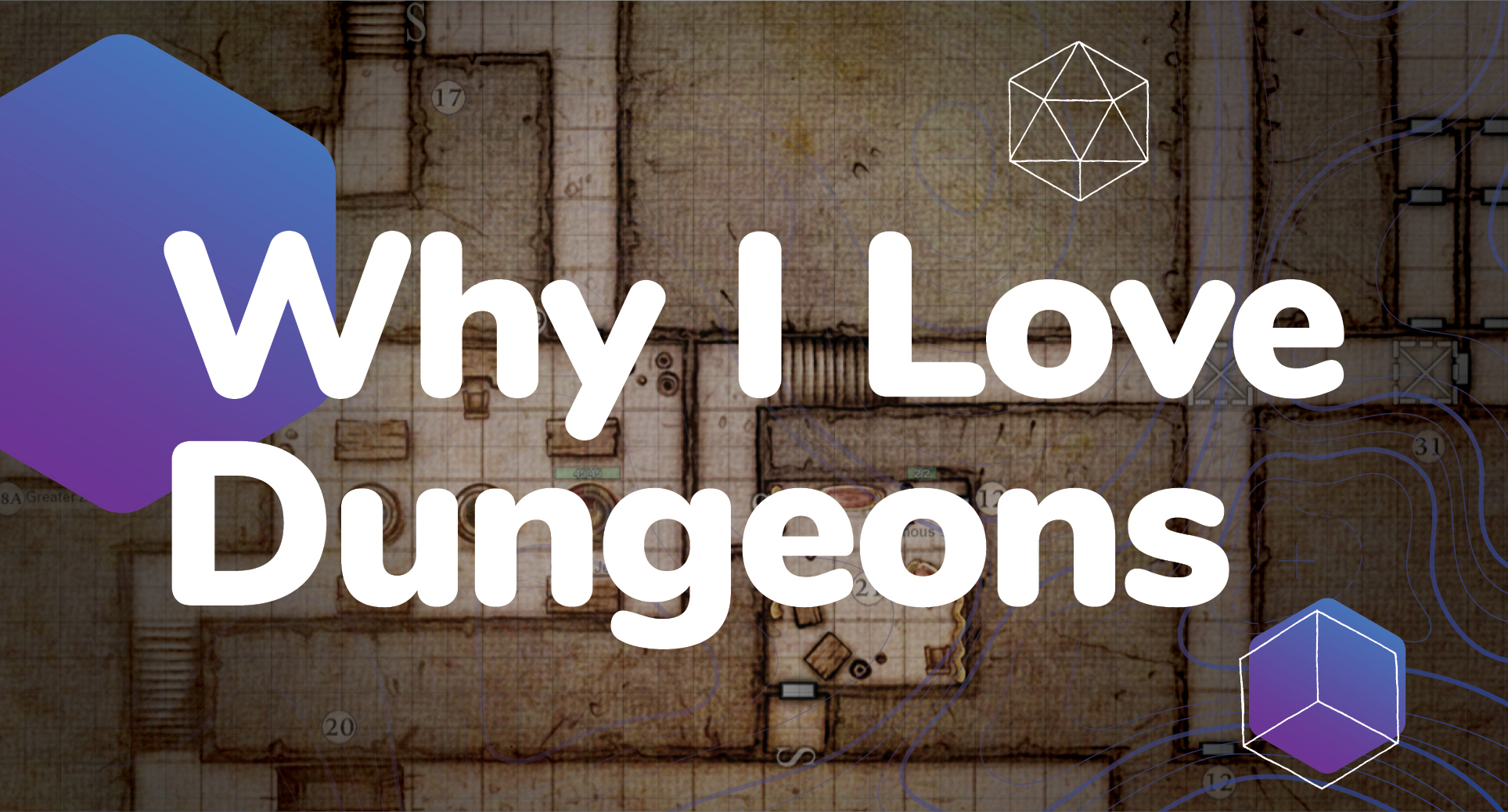
Luke
Emerging from the trap door, you come into a closed space with a wheel-and-spoke layout. Surrounding the octagonal room there are 8 mini-chambers, each set off with a sort of mirrored partition. At the center of the room, ornate and ancient runes are sketched into the floor. They glow and hum with some arcane enchantment. But before you can really study their shape, your eye catches on what lies atop them; a corpse, half-decayed, still-decaying, covered partially with dusty rubble. Water drips on to the body from some unknown source. You look up. Right above the body, there’s another trap door — just like the one you used to get here. And it seems to be the only way out.
What made the dungeon crawl so synonymous with tabletop roleplaying?
There’s an academic answer to this question. Early roleplaying games were created because friends wanted to adventure in worlds inspired by stories like The Hobbit and the Conan series, and dungeon crawls were a basic mainstay of these kinds of fantasy/sword & sorcery works. That’s reductive, sure, there’s much more to it than that, but it’s a pretty sufficient answer to the question of why dungeons and RPGs grew up together.
But that’s not the question I’m here to answer. I’m here to talk about why dungeons are such a powerful expression of what I love about tabletop roleplaying games. Why the dungeon, as a basic unit of play, makes me so excited to get together and explore with my friends. What drives me to keep searching dark corners of forgotten, ancient tombs, even after I’ve already burned through 3 or 4 characters in a long campaign. I’m here, basically, to explain why I love dungeons.
Considered Space
If you play games for a long enough time, you start to see the matrix behind their design. You begin to unravel the internal logic of the game, and in that process, some of the magic wears away. Think about playing Super Mario Bros. as a kid, and what it was like to find a hidden 1UP mushroom in some invisible block. Your mind boggled with possibilities. There could be a mushroom anywhere, you’d say to yourself, and wide-eyed, you’d start jumping wildly, trying to discover everything the game has to offer.
Flash-forward to now, and the magic isn’t quite the same. You see a suspiciously vacant patch of empty air before a boss, and something tells you that there’s probably a mushroom tucked away nearby to give careful players a safety net. This is because the game is constructed with the player experience in mind. It’s built to be experienced. Bowser doesn’t give much thought to his interior design beyond making things tough for intruding plumbers.
-jpg.jpeg)
These fire sticks are not functional interior design. (Super Mario Bros., Nintendo)
Good dungeons aren’t built this way. Sure, there’s some internal logic that veteran dungeon-crawlers can puzzle out — always carry a 10-ft pole — but good dungeons have a more considered logic to their space, built for the needs and lifestyles of their occupants rather than the convenience of the players.
Good dungeons answer questions about who lives in the space, or more grandly, the purpose of the space itself. If you find a pit of bones, picked-clean, you can be sure that there’s some sort of mean carnivore lurking nearby. And you can be doubly sure that there’s abandoned treasure and supplies at the bottom of that pit of bones, and you can be triply sure that some extremely gross and equally mean scavengers are also hanging out down there.
Yes, there’s a logic to be explored — but instead of catering to the player, following the logic of a player-focused experience, that logic says something about the surrounding world. It raises even more questions that drive you forward even further, deeper into the dungeon, to discover what could be around the next corner. It’s that drive to keep delving that makes dungeons so compelling. A good dungeon is something to be discovered, just as much as it's something to be explored.
Surprises Around Every Corner
OK, now take everything I said in the last section and fling it out the window.
What really elevates a dungeon is not its internal logic, but in the places where the dungeon eschews that logic for an unexpected surprise. I’m talking about the deadly traps and unexpected ambushes that are hallmarks of a great dungeon crawl here.
-png.png)
Learn to expect the unexpected. (Tomb of Horrors, Gary Gygax)
While too many of these surprises can be overly frustrating and lead to a bad play experience, a careful sprinkling of them creates opportunities for the players to solve problems creatively and, in doing so, express themselves as dungeoneers.
Roleplaying games provide so much possibility space. A player can look at a problem and arrive at, more or less, an organic solution to it. It might sound hokey, but those solutions are only limited by imagination. Even if an idea is not present in the written rules of a system, a good GM will figure out a way to represent that idea mechanically. They can reward clever ideas and provide opportunities for players to think and plan outside-the-box.
The dungeon, then, is the perfect space for this interplay between the GM and the player. These are places with strange, unorthodox problems, that require quick-thinking and a clever utilization of limited resources. When the chips are down in a good dungeon, only the sharpest of explorers can rise to the occasion.
Danger, Peril, & Spoils
But victories aren’t the only interesting response to a unique problem. A good dungeon, powered by a good GM, provides opportunities for incredible failure, too.
Trying something unique and then falling on your face may not sound fun, but exploring those limitations and learning from them certainly is. Unlike leveling up or other methods of advancing a character, it’s growth that truly teaches the player.
Failing in the real world can be intimidating. There are consequences, sometimes severe. Facing them with bravery is a tough thing to do.
A good dungeon is something to be discovered, just as much as it's something to be explored.
Dungeons represent something incredibly valuable for me. They’re a place to safely explore that kind of failure with friends. When you step away from the table, the dungeon stays there. It’s a dangerous, treacherous space, but you know that, because of that level of abstraction, there’s some comfort in its damp, danger-packed walls.
In that way, when I’m trapped in a treacherous dungeon, I often feel like I’m really at home. I’m in a place where I can practice my ability to think, creatively and critically, hone my sense of direction, and ultimately, better myself — all while crafting and creating a story with my friends. That to me is worth more than any gold or treasure I might find at the heart of the maze.
Thanks for reading! Come back next week for Part 2: Why I Love Dragons. This is not a bit!
If you're feeling inspired, head to the Roll20 Marketplace. There are tons of great prebuilt modules packed with exciting dungeons. If you're ready to build your own, get started with assets from our Marketplace creators.

